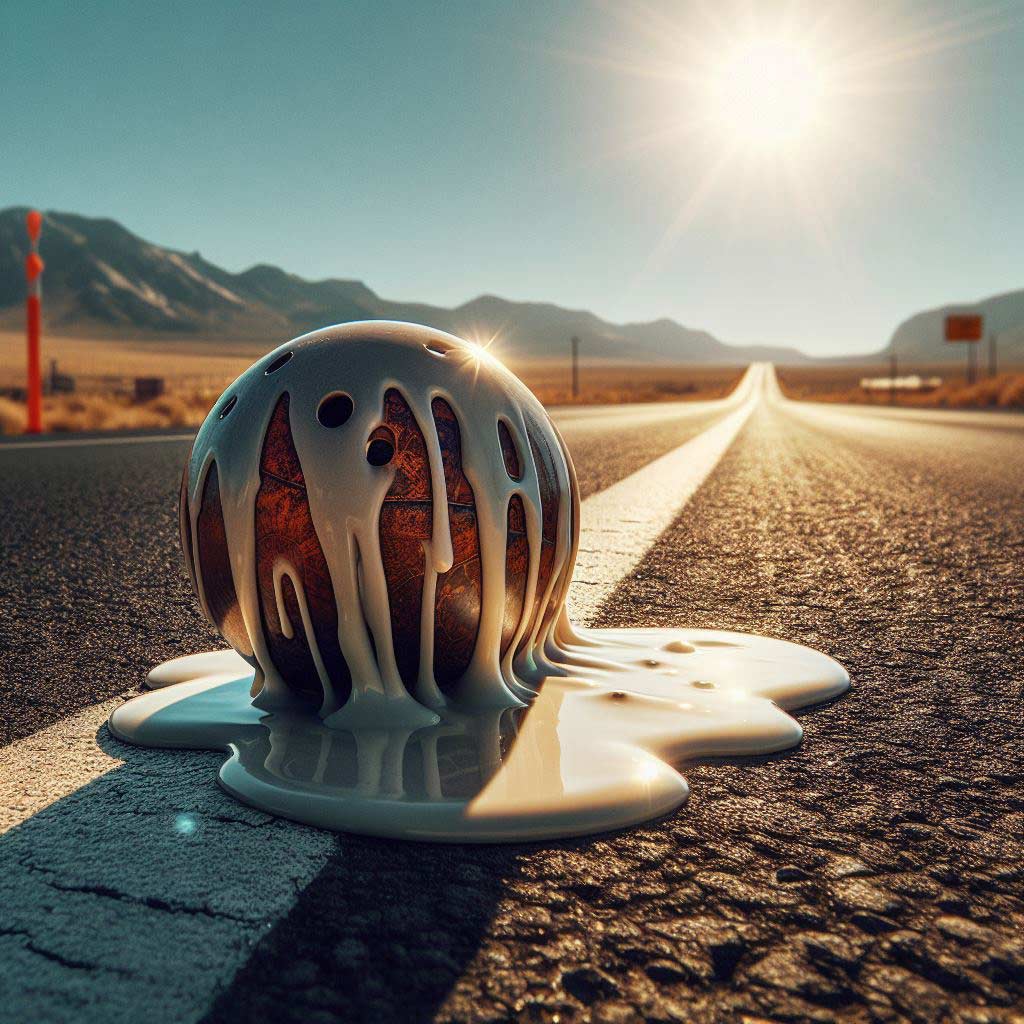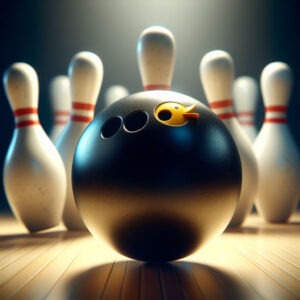Imagine this scenario: you’re grabbing your favorite bowling ball from the trunk of your car after leaving it there all day in the sweltering summer heat.
As you pick it up, you hear an unsettling crack – and your heart sinks. Your trusty bowling ball has developed a hairline fracture, likely due to the extreme temperatures it endured. This unfortunate situation is more common than you might think, leaving many bowlers wondering, “Can bowling balls really break in the heat?“
The answer is a resounding yes. While bowling balls are designed to withstand the impact of repeated strikes against the lane, they aren’t immune to the damaging effects of excessive heat exposure.
In this comprehensive guide, we’ll explore the science behind how heat can compromise bowling ball integrity, the factors that increase the risk of heat damage, and the steps you can take to protect your prized bowling equipment.
What Are Bowling Balls Made Of?
To understand why bowling balls are susceptible to heat damage, we need to examine their construction materials. Most modern bowling balls are made from a combination of three primary materials: polyester, urethane, and reactive resin.
Polyester bowling balls are known for their durability and are often recommended for beginner bowlers. However, polyester has a relatively low melting point, making it more vulnerable to heat damage than other materials.
Urethane bowling balls offer a balanced combination of durability and reactivity (the ability to generate friction and create a desired ball motion on the lane). While urethane has a higher melting point than polyester, it can still deform or become brittle when exposed to extreme temperatures.
Reactive resin bowling balls are the most advanced and expensive option. These balls are designed to generate maximum friction and offer optimal lane performance. However, reactive resin is also the most heat-sensitive material used in bowling ball construction, with a relatively low softening point.
Understanding the materials used in your bowling ball can help you anticipate its potential vulnerability to heat damage.
Can Bowling Balls Break or Crack in Extreme Heat?
The short answer is yes, bowling balls can break or crack when exposed to extreme heat. The science behind this phenomenon lies in the way materials expand and contract in response to temperature changes.
As a bowling ball heats up, the materials it’s made of – polyester, urethane, or reactive resin – will begin to expand. This expansion creates internal stress within the ball’s structure.
If the heat exposure is severe enough, the stress can build to a point where the materials can no longer withstand the pressure, causing cracks or fractures to form.
There are numerous examples of bowling balls breaking due to heat exposure. One particularly alarming case involved a bowler who left their reactive resin ball in a hot car trunk for several hours. When they retrieved the ball, it had developed several large cracks, rendering it unusable.
Factors That Increase the Risk of Heat Damage
While any bowling ball can potentially suffer heat damage, certain factors can increase the risk:
- High Ambient Temperatures: Leaving your bowling ball in a hot car, outdoor storage shed, or other environments with high ambient temperatures is a surefire way to invite trouble.
- Direct Sunlight Exposure: The sun’s rays can act like a magnifying glass, intensifying the heat absorbed by your bowling ball. Prolonged exposure to direct sunlight can be especially damaging.
- Improper Storage or Transportation: Storing or transporting bowling balls in uninsulated containers or areas without climate control can expose them to extreme temperatures.
- Age and Condition of the Bowling Ball: Older bowling balls or those with existing cracks or damage may be more susceptible to heat-related issues.
Preventing Heat Damage to Your Bowling Balls
While the threat of heat damage is real, there are several steps you can take to protect your bowling balls:
- Proper Storage: Always store your bowling balls in a cool, dry place out of direct sunlight. Basements, climate-controlled storage rooms, or specialized bowling ball cabinets are ideal options.
- Use Bowling Ball Cases or Covers: Investing in a well-insulated bowling ball case or cover can provide an extra layer of protection during transportation or storage.
- Avoid Leaving Balls in Hot Environments: Never leave your bowling balls in a hot car, outdoor storage shed, or any other environment that could expose them to extreme temperatures for extended periods.
- Regular Inspections: Periodically inspect your bowling balls for any signs of cracks, discoloration, or other damage that could indicate heat exposure or compromise their structural integrity.
What to Do If Your Bowling Ball Is Damaged by Heat
Despite your best efforts, heat damage can still occur. If you suspect your bowling ball has been compromised by heat exposure, here are some steps to take:
- Inspect for Signs of Damage: Look for cracks, hairline fractures, discoloration, or warping – all potential indicators of heat damage.
- Consult with a Professional: If you notice any signs of damage, consult with a professional bowling ball driller or pro shop operator. They can assess the extent of the damage and recommend repair options or replacement.
- Contact the Manufacturer: In some cases, the bowling ball manufacturer may offer repair services or replacements under warranty for heat-related damage.
Myths and Misconceptions About Bowling Balls and Heat
As with any topic, there are several myths and misconceptions surrounding bowling balls and heat exposure that need to be addressed:
Myth: “All bowling balls are heat-resistant.” Truth: While some bowling ball materials are more heat-resistant than others, no bowling ball is completely immune to the effects of extreme heat exposure. Proper care and storage are essential for all bowling balls.
Myth: “Minor heat exposure won’t damage my bowling ball.” Truth: Even seemingly minor heat exposure can cause internal stress and potential damage over time. It’s best to avoid any unnecessary heat exposure to prolong the life of your bowling ball.
Myth: “Older bowling balls are more heat-resistant.” Truth: In reality, older bowling balls may be more susceptible to heat damage due to pre-existing wear and tear or potential material degradation over time.
By separating fact from fiction, bowlers can make informed decisions about how to care for and protect their equipment.
Conclusion:
Bowling balls, like most sports equipment, are not immune to the damaging effects of excessive heat exposure. The materials used in their construction – polyester, urethane, and reactive resin – can expand, warp, or even crack under extreme temperatures.
To avoid the heartbreak of a heat-damaged bowling ball, it’s crucial to follow proper storage and transportation guidelines. Keep your balls in a cool, dry place out of direct sunlight, use insulated cases or covers during transportation, and never leave them in hot environments for extended periods.
If you suspect your bowling ball has suffered heat damage, don’t hesitate to consult with a professional or contact the manufacturer. Addressing the issue promptly can sometimes salvage the ball or at least prevent further damage.
Remember, investing in quality bowling equipment is a significant commitment, both financially and emotionally. By understanding the risks of heat exposure and taking the necessary precautions, you can protect your bowling balls and ensure they remain reliable companions on the lanes for years to come.





